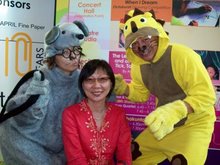好友琬珍今天亲手做了很多粿桃送到家里l
但我却有事外出,回到家已过了七点半!肚子虽饿,却不舍得吃!
先拍个照畄念 :
看! 小熊猫也流口水!

"Travel down memory lane with Dexterine" Topic posted was selected based on theme in various subjects/activities. Retrospective or reflective method is used for recording and analysing some events. Descriptive or narrative method is applied to other topics. A photograph can speak a thousand words. Hence, digital image may speak for itself. Yet, to make it clearer, I may use retrospective, reflective, descriptive or narrative caption to illustrate it. dexterine@yahoo.com smho@e.ntu.edu.sg
Agenda:
Registration: http://library.smu.edu.sg/conference/2015IL
| ||||||||||||||||||
|


There cannot be a sense of abundance or the experience of prosperity without appreciation.
You cannot find beauty unless you appreciate beauty.
You cannot find friendship unless you appreciate others.
You cannot find love unless you appreciate loving and being loved.
If you wish abundance, appreciate life.
--- William R. Miller
|
